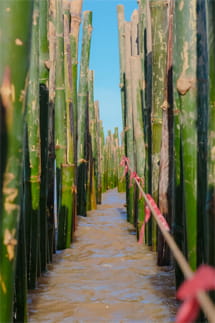Around 50 percent of the world’s mangrove forests have been irreversibly destroyed in the past decades through deforestation, abuse and exploitation. In Vietnam and upstream countries, unsustainable cropping practices, the expansion of resource-intensive aquaculture as well as increased infrastructure development is heavily affecting natural resources along the coastlines. Together with land subsidence and rising sea levels, this puts increasing pressure on the fragile mangrove ecosystems.
 Image: The breakwater fences are made of bamboo poles. © GIZ
Image: The breakwater fences are made of bamboo poles. © GIZ
The loss of forest along the coast is a particularly sensitive issue. This green belt was once a stabilizing force across the coasts, reducing the risk of floods and other hazards. Erosion of entire tidal mudflats leave deep scours and steep embankments, making natural mangrove resettling impossible and needing to be supported through additional measures. Dyke breaches and flooding from the missing mangrove belt threaten the densely populated areas behind them.
The mangrove belt between water and land is shrinking from two sides (the scientific community calls this phenomenon “coastal squeeze”). From the land side, farmers want to claim the valuable forest grounds for farming and shrimp ponds. Further stress comes from irrigation canals that let water flow in two directions: from the Mekong River into the rice paddies and the sea, and from the sea into the shrimp and fishponds on land. Where the canals discharge into the sea, erosion often occurs. Such erosion – the loss of land to the sea – is the main threat for mangroves from the sea, and a huge challenge for the population of the coast: erosion of up to 50 meters per year in some areas means that without intervention, houses that lie 500 meters from the sea today would be at the coastline in ten years.
Our reforestation efforts use nature-based solutions by building bamboo breakwater fences that support mudflat aggregation for a renewed plantation of mangrove seedlings. By this contribution to restoring the ecosystem, we also strive to secure the livelihood for many people.